Jihadi Preachers
The silence of many surrounding the vile hate speech of Muslim clerics says a lot about the threats within the West.
Tracking the quality of the food we consume to fuel our bodies is critical to maintaining well-being and optimising our lives. Here's a critical expose of the egg industry.

Not all eggs are created equal. That is a fact that the mega corporations who own about 99% of the egg production in the USA don’t want you to know.
How large are these companies? Here the numbers of hens that the top five egg producing companies own (data from 2021):
Now, people who want humane eggs, often buy “cage-free” but that means little, in terms of humane treatment. “Cage-free” is defined by having the cages removed from their crowded living conditions.
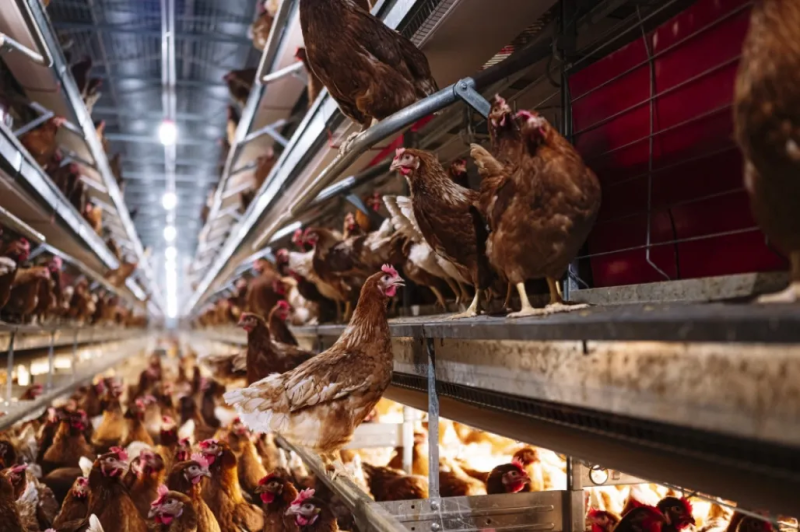
So, free range can be a little better. The USDA has some criteria for what is free range.
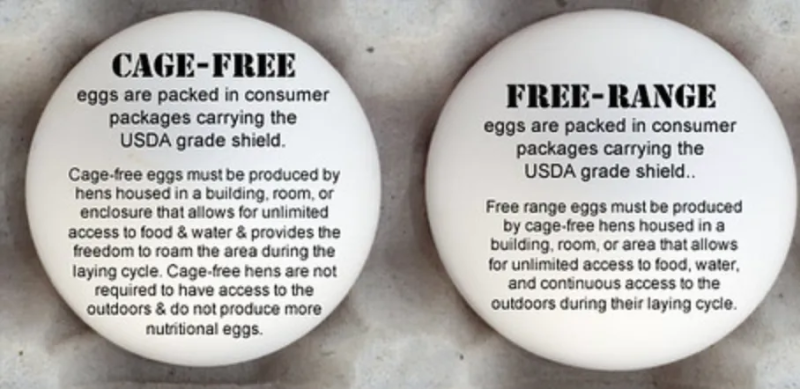
The USDA’s (and industry standards’) definition for “Free Range” is that birds must have “outdoor access” or “access to the outdoors.” In some cases, this can mean access only through a “pop hole,” with no full-body access to the outdoors and no minimum space requirement. Basically a hole in the wall - from which they can stick their heads out of. Sort of.
But all this jargon skirts around the bigger issue, in terms of human wellness and eating eggs. We know that there is a huge difference in egg quality from laying hens that have access to better quality foods and forage.
As much as our government would like to support the large egg producers, the truth is that small farms and “backyard” (at least from those hens that have access to pasture and better food) chicken eggs are healthier.
Recent peer-reviewed papers support this:
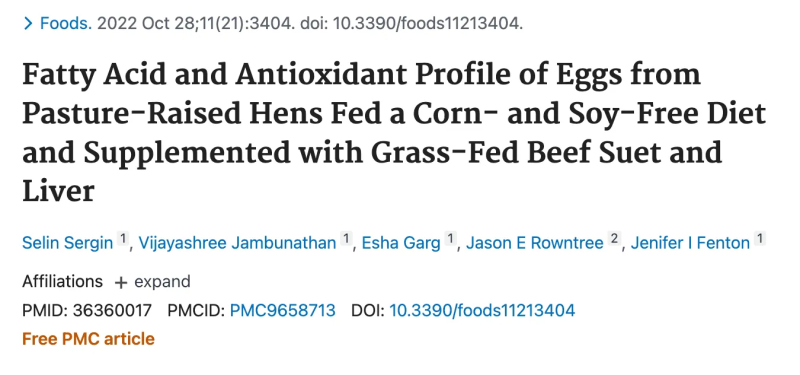
The objective of this study was to characterize egg yolk fatty acid and antioxidant profiles using eggs from pasture-raised hens fed a corn- and soy-free diet and supplemented with GFB suet and liver compared to eggs from pasture-raised hens fed a corn and soy layer hen feed and commercially obtained cage-free eggs. The egg yolk vitamin and mineral profile was also assessed by a commercial laboratory.
Both pasture-raised groups had twice as much carotenoid content, three times as much omega-3 fatty acid content, and a 5−10 times lower omega-6:omega-3 fatty acid ratio compared to the cage-free eggs (p < 0.001). Eggs from hens fed a corn- and soy-free feed and GFB by-products had half as much omega-6 fatty acid content and five times more conjugated linoleic acid, three times more odd-chain fatty acid, and 6−70 times more branched-chain fatty acid content (p < 0.001). s.
Furthermore, the use of pesticides and herbicides in poultry foods used in the commercial poultry industry may have long-term consequences for human health - something that has not been adequately studied.
Although the effects of dietary exposure to glyphosate in the broiler hen diet has.
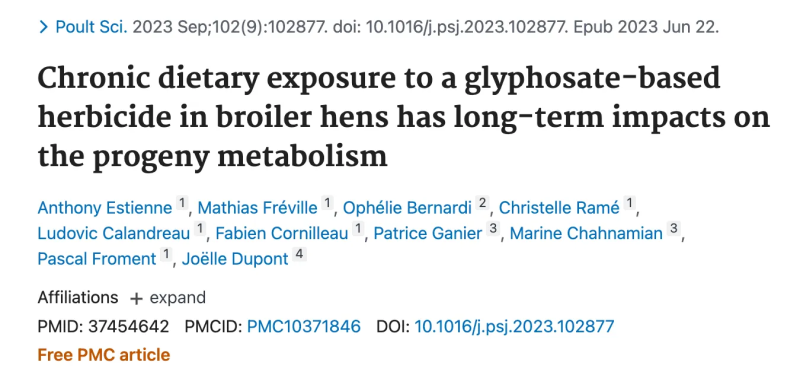
The present study demonstrates that an exposure to a GBH in hens has behavioral and metabolic outcomes on the progeny. We show that chicks whose mothers are exposed to a GBH do not have the appropriate fear response to the discovery of a new environment. We also show that despite a normal alimentation, they gain more body weight and they are fatter than chicks whose parents would not have been exposed. Moreover, the fatty acids composition of their abdominal adipose tissue is disturbed, which could have bad consequences on their health as growing animals and later as adults.
The effects of pesticide residues on grains on other (wild type) poultry has also been shown to have long-term consequences to offspring:
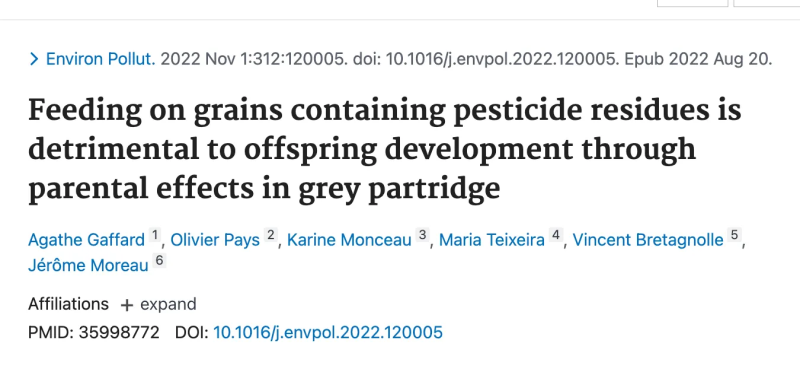
Numerous toxicological studies have shown that ingestion of pesticides can induce physiological stress in breeding birds, with adverse consequences on egg-laying parameters and offspring quality through parental effects. However, previous studies do not mimic current levels of pesticide residues in typical landscapes, and they do not consider potential cocktail effects of pesticides as they occur in the wild.
Herein, we explored whether realistic pesticide exposure affected reproduction parameters and offspring condition through parental effects in Grey partridge. We fed 24 breeding pairs with either seeds from conventional agriculture crops treated with various pesticides during cropping, or organic grains without pesticide residues as controls. The conventional and organic grain diets mimicked food options potentially encountered by wild birds in the field. The results showed that ingesting low pesticide doses over a long period had consequences on reproduction and offspring quality without altering mortality in parents or chicks.
Compared with organic pairs, conventional pairs yielded smaller chicks at hatching that had a lower body mass index at 24 days old. Additionally, these chicks displayed lower haematocrit when body mass index was higher. Therefore, ingestion of conventional grains by parents resulted in chronic exposure to pesticide residues, even at low doses, and this had detrimental consequences on offspring.
These results demonstrate a sublethal effect of pesticide residues through parental effects. The consequences of parental exposure on chicks might partly explain the decline in wild Grey partridge populations, which raises questions for avian conservation and demography if current agrosystem approaches are continued.
These, and many more such studies with very similar results document that this is a serious issue that goes beyond the nutrients of egg composition.
Of course it does. Luckily, the USDA has an interest in egg production and has funded many avian and nutritional scientists to assess different diets in laying birds.

CONCLUSIONS: Based on the results of the present study, the use of dietary flaxseed oil increased the n-3 PUFA (Polyunsaturated fatty acids) content and decreased the n-6/n-3 proportion content in egg yolk which achieved the study goal of producing functional and designer eggs. In addition, the use of flaxseed oil, canola oil, vitamin E, or ginger as feed supplements during the laying period of Japanese quail positively affected productivity, blood hematology, constituents, resistance, lipid digestion system, and antioxidative properties in serum and egg yolk. <Note: “n” is the same as omega>
So, a hen fed a diet rich in omega 3 foods will yield eggs that are rich in omega 3s. This should be well known to most by now.
But what about other nutrients, such as found in pastures?

RESULTS: Three hundred and sixty Ancona hens were randomly assigned to three groups: a control group (C), with the hens kept in cages under standard housing conditions; the organic group (O), with the hens kept under an organic production system (4 m2 per hen) and the organic-plus group (OP), with the hens maintained under organic conditions but with a larger grass paddock availability (10 m2 per hen).
The estimated intake of forage, carotenoids, and flavonoids of the OP hens was very high as the amounts deposited in eggs, mainly in the spring season. The fatty acid composition of the yolk was significantly affected by pasture. The OP eggs showed lower concentrations of polyunsaturated fatty acids (PUFA) n-6 and a higher percentage of PUFA n-3.
So a forage diet increased omega-3 fatty acids, but also significantly other nutrients such as carotenoids and flavonoids.
After reading through many studies on avian nutrition, I come back to the conclusion that the best eggs come from small farms and backyards. That if one does choose to have chickens, then using organic feeds, healthy organic leftovers, (including meat) and pasture are the way to ensure that the eggs produced are superior to store-bought. That it is not enough to just buy some chickens, keep them in an indoor coop, and feed them cheapest poultry “pellets” money can buy from a big-box store.
If you do have to coop-keep your chickens, it is a good idea to supplement with greens. These can be bought, grown (both purpose grown - such as kale or chard or just the leftover from a harvest). One can also gather greens, such as dandelions or weeds from the garden. We have never had a chicken get sick from ingesting weeds. They seem to be pretty good at figuring out what is edible. During the winter, we sometimes will throw a flake of alfalfa into the chicken coop.
But these studies cited go beyond chickens. Women are born with all the eggs they will have at birth. Having quality eggs is important to birthing a healthy child.
The link between pre-pregnancy maternal hen glyphosate levels and obesity in the hen’s progeny begs the question. Is there such a link in humans?
A December 2023 study documents that individuals with higher levels of glyphosate have a higher likelihood of having Type 2 diabetes, hypertension, cardiovascular disease, and obesity.
A September 2023 study documents that glyphosate exposure has a significant impact on reproductive fitness.
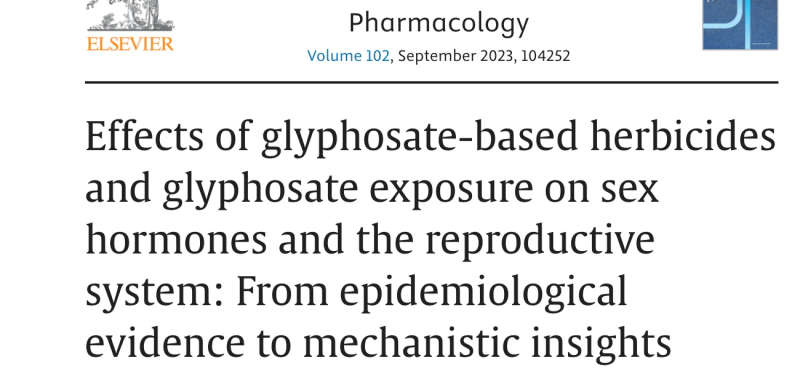
Abstract: Glyphosate-based herbicides (GBHs) containing glyphosate as the active component are extensively used worldwide. Concerns have arisen about their potential risk to human, as glyphosate has been detected in human body fluids. Current controversies surround the endocrine-disrupting properties and transgenerational inheritance of diseases and germline epimutations resulting from exposure to GBHs and glyphosate. This review discusses evidence from in vitro, in vivo, and clinical studies on their impact on sex hormone regulation and reproductive system.
Evidence suggests that they act as endocrine-disrupting chemicals, which altering sex hormone levels. Mechanistically, they interfere with hormone signaling pathways by disrupting proteins involved in hormone transport and metabolism. Pathological changes have been observed in male and female reproductive systems, potentially leading to reproductive toxicity. Prenatal exposure may lead to transgenerational inheritance of pathologies and sperm epimutations. However, due to the complexity of glyphosate formulations containing adjuvants identifying higher risk components in environmental exposure becomes challenging.
The conclusions of this paper are pretty serious, and everyone of reproductive age or younger should take note.
For the sake of future generations, we all have to clean up our diets.
When I started this essay, I planned to focus on the benefits of organic, backyard, or small farm produced eggs. And yes, this is very important to a healthy diet. But as I went farther down the “rabbit hole,” what evolved was more evidence of the dangers of glyphosate-based herbicides. That the nutritional studies performed in poultry have helped give rise to studies of these chemicals on humans. The conclusions of these studies are devastating.
The plant-based diet is rife with foods filed with glyphosates and chemicals - unless one is very careful. This is one of the rabbit holes that made me turn away from a plant-based diet.
As I have documented before, grains usually have a desiccant sprayed on them before harvest. This desiccant is most likely glyphosate based or other toxic chemicals. Glyphosate is linked to a host of diseases. I can’t help but lecturing - diet is important. Eating an organic, nutrient rich diet is essential to good health.
To wrap this up - if you eat a lot of eggs, buying some hens is a great way to go. They are cheap, can be fed almost anything, are hardy, friendly, and don’t stink. Otherwise, buy locally sourced, pasture kept, organic eggs.
Republished from Brownstone.org